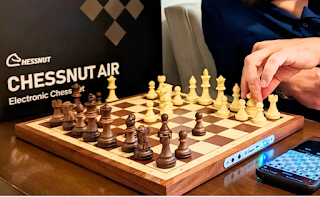In the realm of board games, chess stands out as a timeless classic, revered for its strategic depth and intellectual challenges. Over the centuries, this ancient game has undergone various transformations, from traditional wooden sets to digital adaptations. However, the latest innovation to captivate chess enthusiasts around the globe is the interactive chess board, seamlessly merging the physicality of the game with cutting-edge technology.
Imagine a chessboard that not only serves as a battlefield
for intense matches but also acts as a knowledgeable opponent, a training
companion, or a gateway to a vast online community. This is precisely what an
interactive chess board offers, revolutionizing the way players engage with the
game.
At its core, an interactive chess board typically consists
of a physical board with electronic sensors embedded beneath each square. These
sensors detect the movement of chess pieces, allowing the board to track the
progress of the game in real-time. Paired with a computer or a mobile device,
the board becomes a portal to a myriad of possibilities.
One of the most compelling features of interactive chess
boards is their ability to facilitate gameplay with players located anywhere in
the world. Through online platforms or dedicated apps, users can challenge
opponents from different time zones, fostering a global community of chess
enthusiasts. Whether you're a seasoned grandmaster or a novice seeking to
improve your skills, the opportunity to compete with players of varying
expertise levels is just a click away.
Moreover, interactive chess boards often come equipped with
built-in artificial intelligence, enabling solo play against computer opponents
of adjustable difficulty. This feature serves as a valuable training tool,
allowing players to hone their tactics and strategies at their own pace. With
the ability to analyze moves, suggest improvements, and provide insightful
feedback, these AI-powered opponents offer a dynamic learning experience for
players of all levels.
Beyond gameplay, interactive chess boards offer a range of
educational benefits, particularly in academic settings. By integrating
technology into the learning process, educators can enhance students'
understanding of critical thinking, problem-solving, and decision-making
skills. The tactile nature of the board, coupled with interactive digital
elements, creates an immersive learning environment that appeals to learners of
all ages.
In addition to educational applications, interactive chess
boards have found their way into professional settings, where they serve as
tools for analysis and collaboration. Chess coaches and analysts utilize these
boards to review and dissect games, identifying strengths, weaknesses, and
opportunities for improvement. The intuitive interface and interactive features
streamline the process of exploring complex chess positions, making it easier
to unravel the intricacies of the game.
Furthermore, interactive chess boards have opened up new
avenues for innovation and creativity within the realm of chess. Developers
continue to push the boundaries of what's possible, introducing new features
such as augmented reality overlays, voice command functionality, and
compatibility with virtual reality headsets. These advancements not only
enhance the gameplay experience but also attract new audiences to the world of
chess, ensuring its continued relevance in the digital age.
In conclusion, the rise of interactive chess boards
represents a convergence of tradition and technology, breathing new life into
the ancient game. By blending the physicality of the board with the power of
digital innovation, these platforms offer an unparalleled chess experience that
transcends geographical boundaries and skill levels. Whether you're a casual
player looking for a friendly match or a serious competitor seeking to sharpen
your skills, an interactive chess board opens doors to a world of possibilities,
where every move is an adventure waiting to unfold.








.jpg)


0 Comments